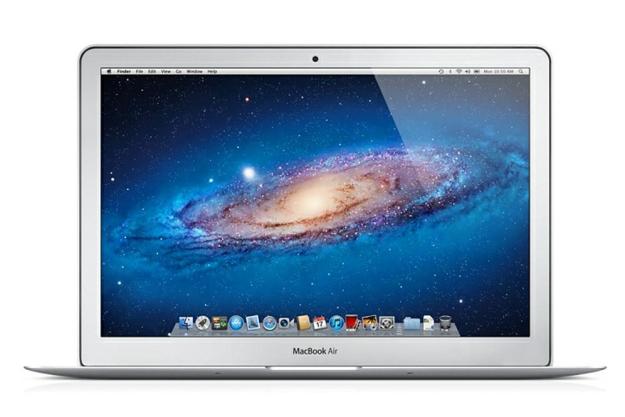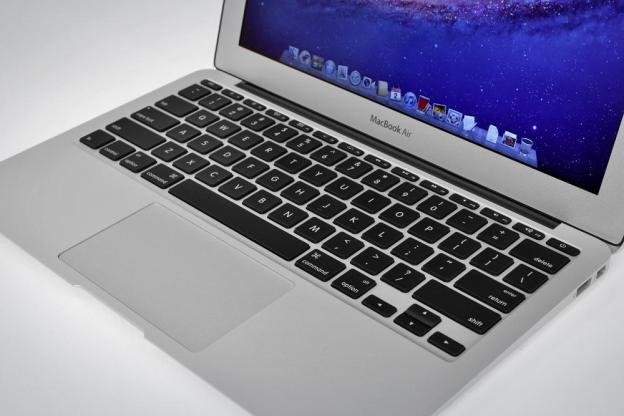
“No matter what Air you decide on, you’ll end up with an incredible product that remains one step ahead of Ultrabooks.”
- Excellent user interface
- Light and portable
- Bright, beautiful display
- Snappy performance
- Competitive starting price
- Best bundled software in the business
- Limited port selection
- Merely adequate battery life
- Squeaking space bar
The Ultrabook craze that’s swept across the PC market exists in the looming shadow of one single, insanely successful laptop — the MacBook Air. This is a bit ironic given the criticism that faced the original Air (which hit stores about four years ago, believe it or not). Everyone agreed it was beautiful and wonderfully built. But would consumers really go for a thin laptop without a removable battery, few ports and a less powerful processor? Not everyone was convinced.
Since then, the Air has proven a success for Apple, but this has done nothing to answer the unspoken question:
Do consumers buy the MacBook Air because it is thin and attractive? Or do they buy it because it’s the MacBook Air?
Apple seems to be leaning towards the second answer — if it feels threatened, it’s not showing it. Cupertino has done little besides update the hardware to take advantage of the latest third-generation Core processors. The RAM has also been upgraded (from a base of 2GB to 4GB) and a new 256GB solid-state memory option is available. Pricing for the 11.6” version is still $999, but the larger cousin has a base of $1,199.
Is such a minor revision enough to keep the MacBook Air at the top of its class? Let’s find out.
You’ve seen this before
Okay, we’ll say it. The trademark silver-and-black is starting to seem a bit common. The same problem faces any luxury brand. When a new style becomes wildly popular, everyone tries to copy it — and each copy makes the original look a bit less unique that it did before.

But the copies still have trouble achieving the same quality. We review many laptops here at Digital Trends, so those around us are used to seeing the latest and greatest — but the Air still stunned friends, family, and passersby. People quickly noticed its solid build and robust materials. One person commented “I feel like I could kill somebody with it.”
The only issue is a familiar one: ports. The Macbook Air offers two USB 3.0 ports, Thunderbolt, and a combo headphone-microphone jack. That’s it. Usually, that’s enough, but this machine isn’t built to be a desktop replacement and it will struggle if you try to use it as one.
Normal Keyboard, Smaller Touchpad
Small laptops are not foreign to cramped keyboards and uncomfortable ergonomics, yet you’ll find no such problems with the Air. The 11.6” Air is just large enough to be comfortable but still small enough to seemingly disappear when you need extra desk space.
The Air offers a nearly edge-to-edge keyboard that provides maximum space in its minimal chassis. If you’ve ever used a MacBook keyboard before you’ll be familiar with this one, and if you haven’t, you’re missing out. In fact, the Air’s keyboard may be its most important technical accomplishment. This laptop is incredibly thin, yet key travel is sufficient to provide some tactile feel, something many PC competitors can’t claim.

Our only complaint with the keyboard was the spacebar. It squeaked slightly and had a different feel from other keys. Apple told us that this was not supposed to occur. Defect? Probably.
Though the 11.6-inch version does not compromise the keyboard it does slightly compromise the touchpad. The surface is smaller than what you’d receive with the 13.3-inch Air and the various MacBook Pro models. Fortunately, the surface that is available works as you’d expect. Scrolling is butter smooth and OS X gestures function normally.
Small and beautiful display
The smaller version of the Air comes with a 1366 x 768 display. This resolution is often disappointing on larger laptops, but when crammed into an 11.6-inch display it provides an extremely crisp picture. Apple isn’t ahead of the competition in this respect, however, as there are several similar PC
Quality is where this laptop leaps ahead of the pack. Test images revealed black levels that are a bit better than average, excellent contrast, and no banding. While the display is glossy, the backlight is bright enough to overwhelm reflections, making the Air usable outdoors. Viewing angles could be better, but are sufficient for a laptop of this size.
The sound is clear and crisp, with minimal distortion. But it is not very loud. This is a small, thin laptop, so there’s no room for larger speakers. And bass? Forgettaboutit — or buy a pair of external speakers.
Cooler than before
Many MacBook models have had trouble with heat. The original Air could become a bit toasty, and even the 13.3-inch version we looked at last year often felt warm.
It seems that the new Ivy Bridge processors have mostly resolved this problem. We noticed nearly no heat emanating from the Air while we performed simple tasks like Web surfing and document editing. Ramping up the load can make the Air much warmer — in fact, bottom temperatures of just over 100 degrees Fahrenheit are still possible, but you won’t notice this unless the processor is really being pushed.
Smaller laptop means smaller battery
Of course the Air is portable. It weighs a tad under 2.4 pounds and is about .7 inches thin at its thickest point. Forget the envelope. You don’t need it, or any bag or case, for short trips. You can pick up the Air and go – provided the battery is willing. So is it?

We can’t use our normal battery benchmarks with OS X so we have to use estimates rather than precise measurements. Our impression is that battery endurance is adequate. The smaller size of the Air requires a smaller battery, which negates the advantage of the low-voltage processor. Moderate Web surfing and online productivity netted us a run time of just under five hours with the display at or near maximum brightness.
YouTube and online games definitely drain the battery more quickly, eating over half of its power in just two hours. A particularly heavy usage pattern could exhaust the Air in three to four hours.
Luckily, it’s not a burden to pack the power adapter for long trips. It’s small and the extension cord can be detached and left at home if you don’t feel the need for it.
Excellent software suite
This being a MacBook, the Air ships with OS X. Apple’s operating system has always felt particularly at home on small computers such as this. The multi-touch gestures and multi-tasking features, such a Mission Control, make it possible to extract a lot more productivity from a small display area.
Potential buyers shouldn’t forget the value of bundled software, either. The iLife suite, which includes Mac staples like iMovie and GarageBand, comes bundled for free. This bundle stands in contrast to the software found on many PCs, which is often more distracting than it is useful.
Quicker than ever
The MacBook Air will not run our normal benchmarks, which once again leaves us without the ability to directly compare it to Windows machines. With that said, there’s nothing exotic about the hardware and so we don’t think any surprises will be found lurking in this laptop’s small frame.
The third-generation Core i5 low-voltage processor is far from the quickest in Intel’s current line-up, but remains among the quickest laptop processors ever made. We found that the Air had no problem handling day-to-day tasks. Apps loaded quickly, files saved or encoded in a snap and multi-tab browsing was a cinch.
We suspect that the solid state memory has just as much to do with the laptop’s snappy performance. Solid-state memory can access data much more quickly and also transfer data at a high speed. This results in short application load times and quick file transfers.
The real downside for Air owners is not going to be general day-to-day performance but instead gaming performance. Intel HD 4000 is the only option, and while it’s adequate for many older 3D titles, it isn’t great for new games. PC games are usually coded for Windows and DirectX first, while OpenGL is an after-thought, so a Mac’s performance, compared to that of many Windows machines, is sometimes yawn-worthy.
If you’re serious about PC gaming, you should buy a Windows machine; but if Apple is your only love, do yourself a favor and buy a MacBook Pro with discrete graphics.
Conclusion
After a year of releases from PC manufacturers, the MacBook Air remains the ultra-thin laptop that sets the standard for the industry. Its build quality, design, and value are difficult for any PC alternative to match. Most can rival the MacBook Air in one or two areas but don’t offer the complete package.
Our only serious complaint about the 11.6-inch rendition of the new Air is battery life. We received a bit less than five hours of life, which is spot-on with what Apple claims. That’s adequate, but a lot of PC alternatives offer better endurance.
Potential buyers should not forget about the 13.3-inch model. Though slightly larger and more expensive it resolves the battery issues and offers a higher display resolution. The larger version will also be more comfortable for many users because of its display area and larger palm rests.
No matter what Air you decide on, you’ll end up with an incredible product that remains one step ahead of Ultrabooks. This is a brilliant, beautiful and useful laptop.
Highs
- Excellent user interface
- Light and portable
- Bright, beautiful display
- Snappy performance
- Competitive starting price
- Best bundled software in the business
Lows
- Limited port selection
- Merely adequate battery life
- Squeaking space bar
Editors' Recommendations
- The XPS 16 is fighting an uphill battle against the MacBook Pro
- MacBook Pro 16 vs. MacBook Pro 14: The important differences
- Best refurbished MacBook deals: Get a MacBook Air for $140 and more
- Best student laptop deals: Laptops for college from $215
- Best MacBook deals: Get an Air for $605 and save on M3 MacBook Pro



